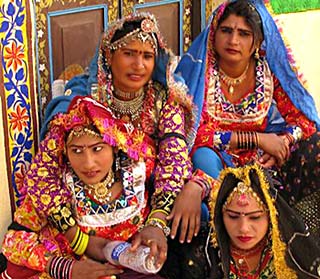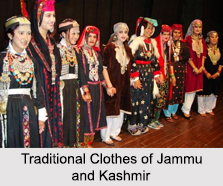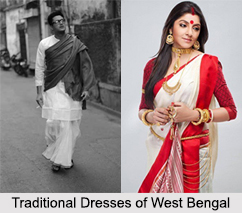 Colour symbolism in Rajasthani costumes itself is a very interesting aspect of their dressing style. The use of colour is widespread in almost all kinds of Rajasthani attire and ornamentation. Throughout history, colour has held an important aspect in Indian culture and Rajasthani costumes are no exceptions.
Colour symbolism in Rajasthani costumes itself is a very interesting aspect of their dressing style. The use of colour is widespread in almost all kinds of Rajasthani attire and ornamentation. Throughout history, colour has held an important aspect in Indian culture and Rajasthani costumes are no exceptions.
This extensive usage of colours in these garments has important cultural, religious, and climatic associations. Each colour embodies complex and significant connotations in that particular time, space and region. It is also derived from India`s ancient dyeing history and techniques. India has rich resource of madder dyeing and thereby it gave birth to coloured textiles and a maturity of colours that ripened in the Indian sun. Hence any attempt to understand the attire of the people of Rajasthan would be in complete without understanding what each colour denoted and the significance associated with it.
In India colours are closely associated with emotions. They are an important means of conveying moods, seasons, religious values, customs and ceremonial occasions. Rituals and ceremonies are marked by varied hues, each representative of particular traditions. Even to this day, colours in Rajasthan are used to identify communities and social status of the individual. Apart from this colours used in attires also have aesthetic, psychological and biological connotations.
The colours seen in Rajasthani costumes are divided into two categories depending on their end usage. Kachcha or temporary colours are used by unmarried women and married while the widows only use the pakka or permanent colours. Kachcha colours, thus, represent a temporary marital phase, with widowhood being the permanent phase of a woman`s life. Red, yellow, parrot green, and saffron are some colours which are considered to be kachcha, while the pakka colours are grey, brown, dark green, dark blue and maroon. Red is a popular colour visible in Rajasthani costumes and is considered auspicious, denoting well being and joy. Traditionally it is obtained from the root of the manjit plant and is identical with blood or the force of human life. Red is also a sign of a woman`s marital status. The married woman used red sindur (vermillion), on her forehead as embellishment and also wears a `red chunri`. This colour also denotes erotic connotations and is used at the time of marriage. The colour white on the other hand represents purity and is considered to be an embodiment of light. It is also a very male colour and is worn extensively by men. Married women never wear any white coloured garments. They often wear a combination of red and white which is representative of both the aspects of masculine and feminine. White as such is a negation of splendour and signifies simplicity. However men use pure white only at the times of death. Priests use white for religious ceremonies, and may sometimes even use it in conjunction with another colour.
Kesariya is the saffron colour and other shades of yellow that are extensively used in the attire of both men and women and have since the primitive times been regarded as auspicious colours. These are obtained from the precious saffron leaves and in earlier times was a classy and rare colour. The Rajput made much use of kesariya in their clothes as well. This colour was used in their wedding robes and was also associated with the brave warriors who died fighting on the battlefield. When defeat was forthcoming, the Rajput warriors immediately would don saffron robes and ascend the battlefield. They termed this as kesariya karna or a brave deed. Marriage was also termed the same, especially, when it resulted in alliances to protect various land and kingdoms. Yellow is a part of all religious ceremonies and also represents the sun God.
The symbolism of the above mentioned colours and their energies is apparent in the way they are integrated in the everyday attire of the Rajasthani people, especially women. Certain colours and designs are also favoured for certain months. Orange and golden are favoured for the occasion of New Year, or the month of Chaith. In high summer colours of kapasi or light yellow, javai or light peach and motia or pearl pink is worn for their cooling affect. Savan or the months of the rainy season are greeted with green garments, which depict prosperity and joy. A green leheriya dupatta is worn during this season. A kasuvud or red odhna is worn at the time of teej, a festival celebrated by women to pray for the long life of their husbands. The festival of Diwali is also brightened with colours of red and yellow. The Rajput women usually wear a deep purple odhni on Diwali. Thus each colour has its own specific significance in Rajasthani costumes, meaning and is also worn depending on customs, time of the year and occasion.
Colour symbolism in Rajasthani dress has deep significance in religious ceremonies and festivals. This vast spectrum of colour on clothing and materials is accomplished through the well known process known as dyeing. Dyeing is the technique of colouring fabric and yarn by immersing the fabric in a solution of colouring substance obtained from vegetable, animal or mineral sources. As a consequence of the vital status of dyeing in the Indian tradition, almost unrivalled skills were developed, especially in the art of fixing colour on fabric. Mordants are chemical agents which react with a fugitive dye and assist in fixing it to the fabric. In Rajasthan, through centuries, communities have specialized in the production of specific crafts. This has led the dyers of the region, rangrez or neelgar as they are called, to establish a special place in the social order. Many villages or their surrounding areas are famous for their local textiles and textile designs. Dyeing is actually the art that has made colours so important in Rajasthani costumes.
Colours denote various moods of a person and also the stages of his/her life. Colours that are usually seen on Rajasthani costumes carry ample meaning to speak of the individual`s status. Thus, colour symbolism in the costumes of Rajasthan has been carrying forward its marvelous tradition of vivacity.





















